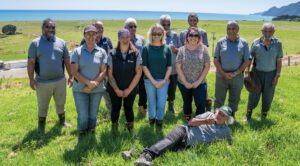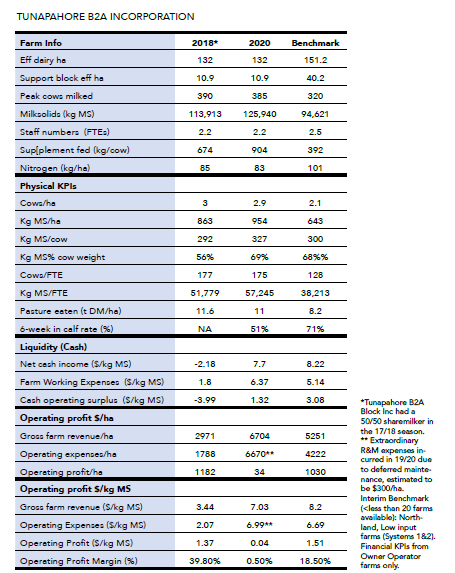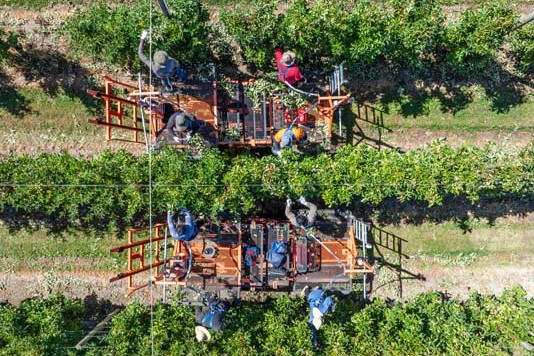Things are changing for the better at Tunapahore B2A Incorporation (TB2A), at Torere on the East Coast, with the iwi doing it for themselves. Elaine Fisher reports. Photos: Alphapix.
A strong balance sheet, loyal staff, a willingness to embrace change and to seek expert advice are among the attributes which not only contribute to the success of Tunapahore B2A Incorporation as a dairy operation, but are also among the reasons it is a finalist in the 2021 Ahuwhenua Trophy for excellence in Māori farming.
It was the incorporation’s financial stability which, in 2018, enabled the Committee of Management to quickly transition from a 50:50 sharemilker to 100% herd ownership on the 132-hectare milking platform at Tōrere on the North Island’s east coast.

Front row: Stella Taku (Committee of Management) Janet Poihipi (Farm Manager) Lisa Dodds (Carlsen Dodds Ltd – Accountant) Sarah Abbot (Carlsen Dodds Ltd – Secretary) and lying on the ground in front is Tau Rewharewha (Committee of Management).
Also key to the successful operation of the farm then and now is Janet Poihipi who after 14 years working on the farm, at very short notice, took on the role of farm manager.
Chairman of the Committee of Management (COM) Jack Mihaere says the committee acknowledges Janet’s role, both as tāngata whenua and for taking on the responsibilities of sole charge farm manager, especially during the transition from 50:50 sharemilking.
“It is clear to us that she has a deep affection for the land and animals. Janet is regarded as an absolute asset to the incorporation.”
In April 2018, when the sharemilkers decided they no longer wanted to continue farming, the COM had just a few weeks to hire staff and buy a dairy herd and plant and equipment. Ahuwhenua judges said this was a huge undertaking, which showed the committee members’ “progressiveness, ability and willingness to roll up their sleeves and assist wherever necessary to get things moving”.
The judges were also impressed by the committee’s strong understanding of the business.
“We were very impressed with how the COM are open in acknowledging what they don’t know, and their willingness to learn, as well as to seek advice and support on different aspects of their business where necessary. Governance training is an important part of this.”
Jack, himself a former farmer, says seeking expert advice and learning from other farmers is vital. “We have some ex-farmers on the committee but you’re talking back in the 1960s when things were more simple. For modern farming you’ve virtually got to be a scientist. We willingly accept we don’t know everything, so we bring in good people to help.”
Now in its third season of full herd ownership, Tunapahore B2A Incorporation (TB2A) is a coastal farm of 132 effective hectares milking 385 cows producing about 126,000kg milksolids (MS).
It is on State Highway 35 on the East Coast of the North Island and is a mix of flats and rolling to steeper hills. The very steep hill country is leased for forestry and regenerating native forestry under a Department of Conservation Ngā Whenua Rāhui kawenata fund.
The climate is coastal and prone to summer droughts particularly in the last two years.
The property has two quality houses, a half-round calf shed, implement shed and a 40-aside Herringbone dairy shed.
A good water supply comes from the Waipuna Stream with a backup from the farm’s runoff. This source also supplies the kura, marae, and the community. Riparian planting is a priority, particularly in a retired gully and funding has been obtained to support this.
There’s a strong focus on benchmarking, which includes using information provided by farm consultants and from being part of a Ministry of Primary Industries Māori agribusiness cluster.
“There are eight farms in the cluster and most face the same problems so it’s useful to find out how each one deals with them,” Jack says.
“However, what works on other farms sometimes doesn’t work for us and it often comes down to differences in soil types.”
Pastures are carefully managed and monitored and there is a good level of knowledge among staff about pasture covers and feed intake, assisted by LIC’s SPACE™ pasture monitoring system. There is a regular re-grassing programme to improve overall feed grown on the milking platform and purchased maize silage is tested for quality.
The Harvest Dairy Effluent Irrigator Tracking system is used to obtain real-time information on effluent spreading but Jack says unreliable cellphone coverage can be an issue and limits the ability to introduce other smart technology.
While the coastal region can be subjected to summer drought, heavy rain and flooding are also an issue. Three years ago, a storm caused significant erosion which restricted access to part of the farm and became a safety issue for staff and stock.
“We had been frustrated by continued delays in getting resource consent from council to put in a 3m by 1200 culvert. The lack of the culvert hindered our feed pattern because we couldn’t access 40-odd hectares of the farm by tractor and staff had to change their milking procedures to let one row of cows go at a time instead of the whole herd, so they wouldn’t push one another over the side.” In mid-September, consent was finally granted for the expensive and much-needed work.
Tunapahore was originally one whole block between the two coastal points of Hāwai. In 1953 the Māori Land Court decided to split the land, so there are now two blocks known as Tunapahore B2A and Tunapahore B2B.
Jack hopes that one day the two blocks will be reunited. Tunapahore B2A is fostering that aspiration by giving grants this year to young people from both blocks.
“In previous years we have received eight applications for grants. This year we received 17 so we decided to give an equal amount to each applicant. Most are aged 17 to 18 and I hope one day they will see the wisdom of reuniting the two blocks for everyone’s benefit.”
Today TB2A farm consists of a total of 400.83ha located at Hāwai and Tōrere. There is a runoff of 10.93 effective hectares and two other leased areas. One is part of the milking platform (16.5ha) the other is leased for maize silage production (10.1ha.)
Originally the farm was leased for about $2000 per annum. In the late 1980s the Committee of management (COM), along with its farm adviser Alistair Hall, obtained bank funding (using Hall’s own land as security) to bring the farm back under the management of the committee.
It was operated as a dairy farm, originally with a farm manager and later for many years with 50:50 sharemilkers. A lease of the adjacent Tawaputa Block was used to increase the milking platform. A 20-aside Herringbone shed was built, and Mike O’Carroll from Taranaki was the first 50:50 Sharemilker, with Colin Mihaere, nephew of the current chair, as his milker.
The success of the farm has enabled further investment opportunities. In 1985, portions of the hill country were leased to be planted in pine forest with the coastal block harvested in 2014.
Six hectares of this block was returned to the dairy platform and the remaining land left to regenerate to native bush. Within the forest are a number of registered archaeological sites, including the remnants of a pā that would have held up to 300 people. In 2010, a partnership was entered into with Ngā Whenua Rāhui to regenerate native forest.
A 5.54ha Hayward green and Hort16A gold kiwifruit orchard was bought in July 2006. When in 2011 they were threatened by the vine disease Psa-V, the vulnerable Hort16A vines were replaced with the variety known as G3 which is more tolerant of the disease. There has since been a further conversion of 0.55ha of Hayward to G3. The orchard consistently grows quality fruit and is within the top producers for both EastPack and Zespri.
Shares have been purchased in Whakatohea Mussels (Opotiki) Limited, and the Incorporation also owns shares in Fonterra, Zespri, Ballance, Farmlands and EastPack Limited.
Jack says it took some convincing to get the COM members to enter the Ahuwhenua Awards. “They were finding all the excuses under the sun not to enter when I said; ‘too late, I’ve signed the papers’ and all hell let loose.”
However, when against their own expectations, the farm was announced as among the top three finalists, Jack says the committee, farm staff, whanau and wider community were delighted.
“I had hoped we might make the top five but when we made the top three everyone was stoked. I would strongly recommend other Māori farming and horticultural businesses to enter the awards. By entering you can move forward. You don’t know where you are succeeding or failing until judges come and show you and give valuable feedback.”
Having the courage to put its operations up for scrutiny by judges and their peers, the Tunapahore B2A COM has not only brought an increased sense of pride to all involved but also stayed true to its visions statement:
“To create a highly successful business that actively pursues growth to benefit and engage our shareholders and beneficiaries for the future”.





